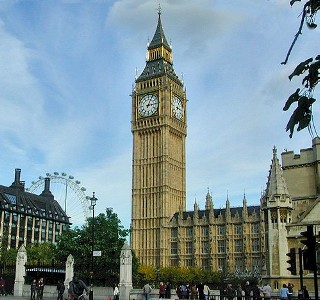 Big Ben, located in the Houses of Parliament in London, is one of London's best-known landmarks, and looks spectacular at night when the clock faces are illuminated. You even know when parliament is in session, because a light shines above the clock face. The name Big Ben actually refers, not to the clock-tower itself, but to the ten-tonne bell hung within. The bell was named after the first commissioner of works, Sir Benjamin Hall. The four dials of the clock are each 7 metres long and wide; the minute hand on each is 4.3 m long, and the numbers are 60 cm high. Big Ben keeps excellent time, and has seldom ever stopped. This is remarkable considering that the hands on the clock are exposed to wind and weather, and that the clock was built in 1851-1854, containing huge mechanisms for turning the hands, accurate to within 1 second per day. Two months after it officially went into service, the bell Big Ben cracked, the cause being a hammer too heavy for the bell it was hitting. After redesigning the hammer, the bell was turned slightly so the crack wouldn't be struck by the hammer. This is the bell as you can hear it today; with the crack, it has a distinctive but less-than-perfect tone. During WWII, in 1941, an incendiary bomb destroyed the Commons chamber of the Houses of Parliament, but the clock tower remained intact and Big Ben continued to keep time; the unique sound of its bell was broadcast to the nation and around the world as a symbol of hope. |